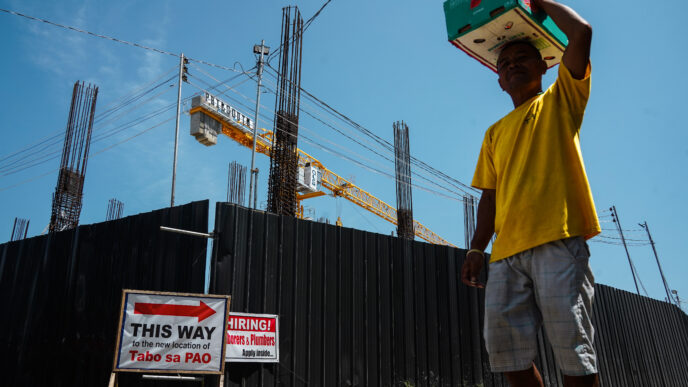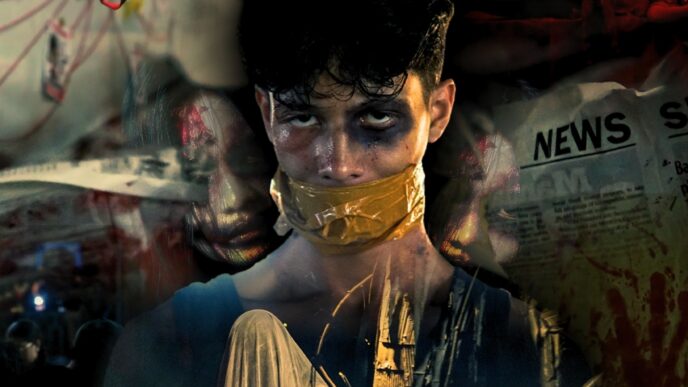By Cynthia Shank
On the once-faded north walls of the Silliman University perimeter facing along the national highway blooms a striking mural—colorful, powerful, and unmistakably alive. It is a gallery without walls, a public conversation wrapped in paint and passion, and it bears a name that speaks volumes: “Tra•baraha•dor.”

This series of murals transforms the concept of labor into an immersive deck of cards. Each figure in the mural represents an essential worker—farmers, janitors, butchers, fisherfolk, and more—portrayed with the dignity of kings and queens.
The main artist statement reads, “TraBARAHAdor,” which translates to “Work Deck.”
“Lain-laing klase sa panginabuhian gipasundayag susama sa baraha. Gipakita niini nga susama sa baraha, adunay lain-laing bahig ang kinabuhi ug pagpaningkamot ang kada tawo. Kinahanglang kumpleto ang mga magbubuhat sa atoang komunidad haron kita mulambo.”
[Different kinds of livelihood are portrayed as playing cards. This shows that, just like cards, each person’s life and hard work hold a unique value. For a community to thrive, all types of workers must be present and acknowledged.]




The project is more than a requirement. The fine arts department showed up, literally and artistically, for the very people who make everyday life possible.
Created between late January to early May 2025, the mural is a product of the Art in Public Spaces class, whose entire philosophy hinges on bringing art out of elite galleries and into the street—where it can breathe, provoke, and belong to everyone.
“It has to be seen by the public,” student muralist Amanda Therese Bumagat says. “That’s the whole point.”
And seen it was. While stationed beside the highway, they became artists and advocates, simultaneously navigating curious passersby, unsolicited critiques, and even the occasional mischief—like a lady who picked up a paintbrush and scribbled on top of their finished work. Still, they painted on.
“The best moments were when older people or teachers would pass by, look at the work, and say thank you,” Mary Pauleen Villahermosa, another student muralist, shared. “That made it worth it.”
“We wanted to say something,” student muralist Beatrice Reluya Laput explains. “But it was always a balance between being loud and staying safe. Between art and activism.”
This year’s mural follows that spirit of social critique but takes a bolder turn. “Portraying workers as playing cards can be read as a commentary on how institutions gamble with people’s livelihoods—whether it’s by executives, companies, or even school administrations,” said student muralist Czar Ian Vergantiños.
“The backs of the cards were designed to look like people protesting. Our first draft was based on photos of SUFA members holding placards in front of the admin building.” He added, “It’s easy to paint something that looks like appreciation. Just make it pretty. But to make it lean toward protest—that’s harder, especially when you’re painting on a wall owned by the very institution you’re critiquing”.
The prior mural, titled Magtanim Ay Di Biro, featured vegetable portraits as a creative way to raise awareness about food security and show appreciation for farmers—particularly those being exploited during ongoing land ownership disputes. It, too, was painted with the brush of activism. It was a subtle symbol of farmers and land rights, portraying them as vegetable people.
The current batch decided: no more whispering. This time, they wanted the message to be visible, not hidden in metaphors.
Laput recounts how the concept developed: a brainstorming session turned word association game that landed on “deck of cards.” It clicked. With playing cards, each face has a worker. “Each profession is its own form of labor,” she adds. “They all have their own brushstrokes.”
Like many student-led projects, “Tra•baraha•dor” came with its weight. Bureaucracy slowed them down. Getting design approval from the Silliman University Buildings and Grounds Office and the Buildings, Projects, and Architecture Office took nearly a month, consuming precious time meant for actual painting.
“We were just hopeful that [BG] would at least give some sort of assistance—like opening the church gate or maybe just one day of power-washing the wall,” said Vergantiños, “I wouldn’t call it a conflict-conflict. It was more of a challenge, but it made things harder. Access to campus was far, and cleaning the wall was kind of impossible.”
But even in the face of red tape and real expenses, they pushed through. “This is reflective of the artist’s economy,” Villahermosa said. “Nothing is handed to us. We had to make it happen through our efforts, our means.”
Ultimately, they are not asking for perfection, nor are they asking for praise. They are asking for a conversation.
“Even if you don’t like the way it’s painted,” said Bumagat, “we hope it gets people to talk—to ask questions about labor, about who keeps our university and society running.” Because that is what art in public spaces is meant to do: disrupt, engage, and include.
“We’re not just here to paint,” Vergantiños added. “We’re here to connect. To give back. To acknowledge. To challenge. And sometimes, to simply be seen.”
As the class ends and these artists prepare for their final year, one thing remains clear: this mural is not the end of the conversation; it is the beginning of a larger one. One that challenges us to look beyond the surface and see the invisible hands that feed, clean, fix, plant, carry, and build.
So next time you walk by the north wall along the highway, pause.
Look. Ask. And maybe say thank you.
Because just like a deck of cards, the system would not work if even one suit is missing.
[The wall was painted by 20 third-year fine arts students, namely: Marie Gertrelle Sumicad, Merianne Marie Catada, Simon Lim, Amanda Therese Bumagat, Czar Ian Vergantiños, Dawn Abrio, Ryla Abrio, Babat Laput, Sofia Lorraine Cimafranca, Beau Cid Tubog, Francis Miguel Capul, MP Villahermosa, Giles Salomon, Ashton Lim, Sjay Ramos, Tala Villa, Eri Vhytryéaz Natividad, Yna Baluran, and Danica Mapeso, and under the guidance of Assistant Professor Irma Lacorte for their major subject, FA 26: Art in Public Spaces.]














